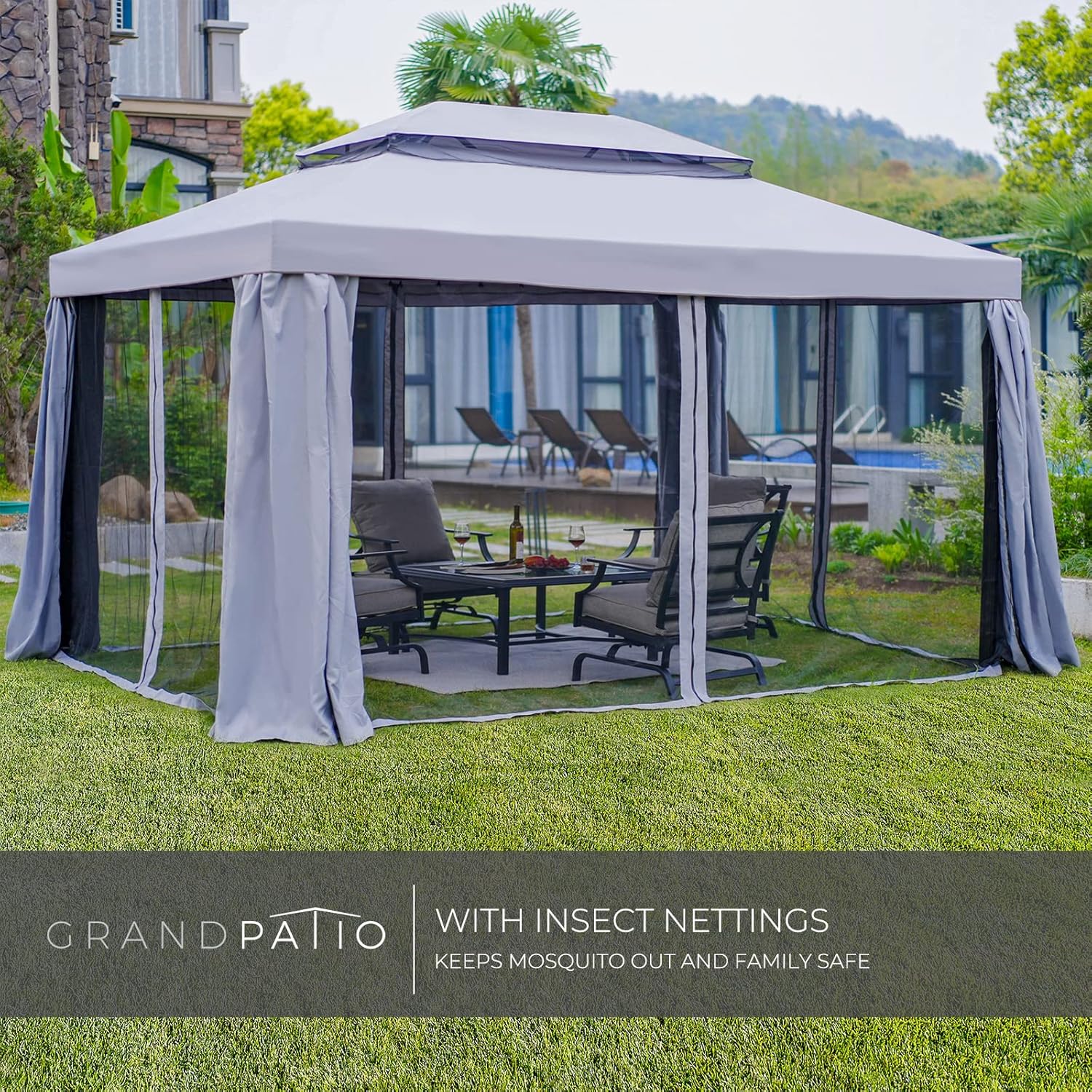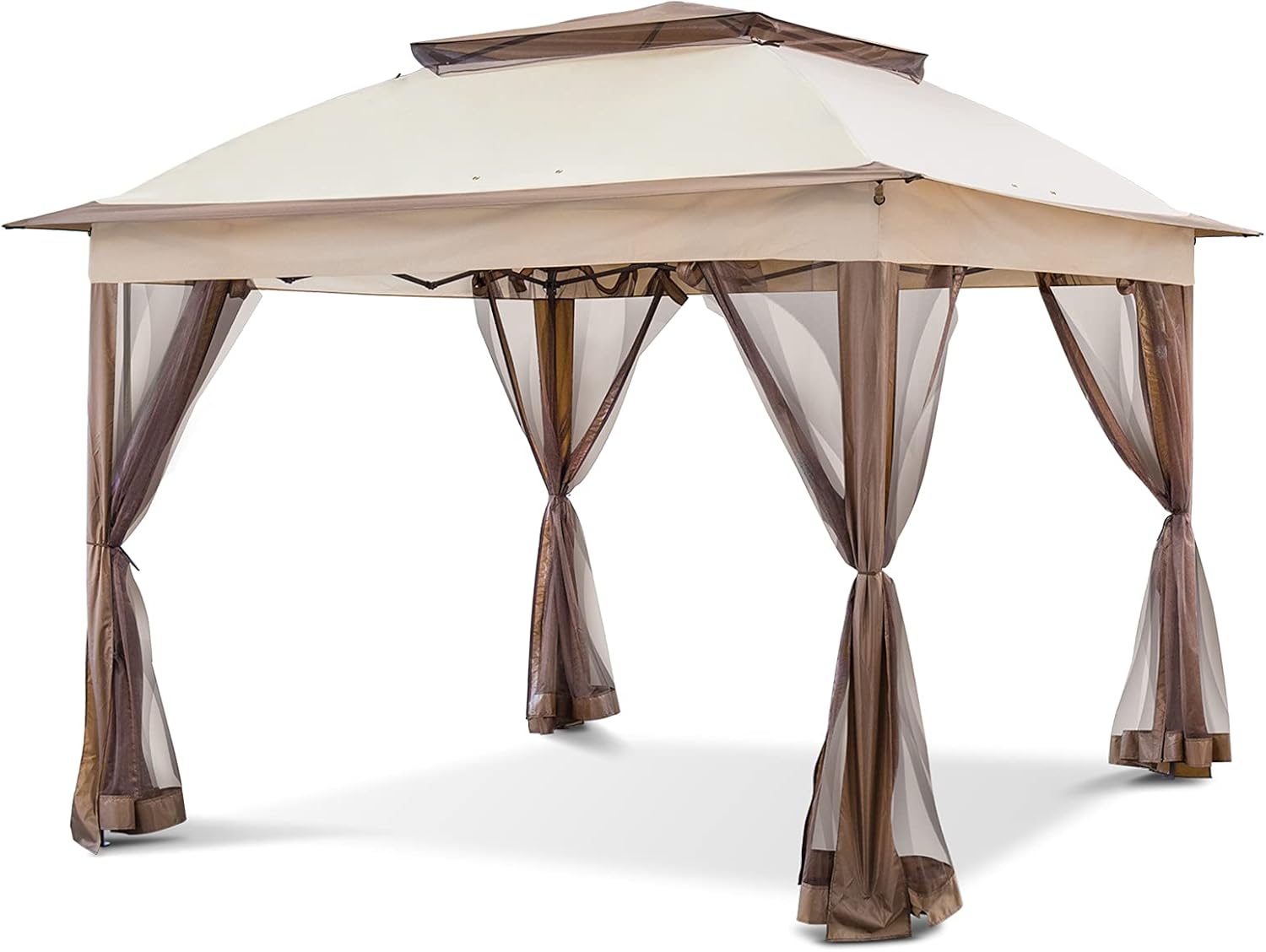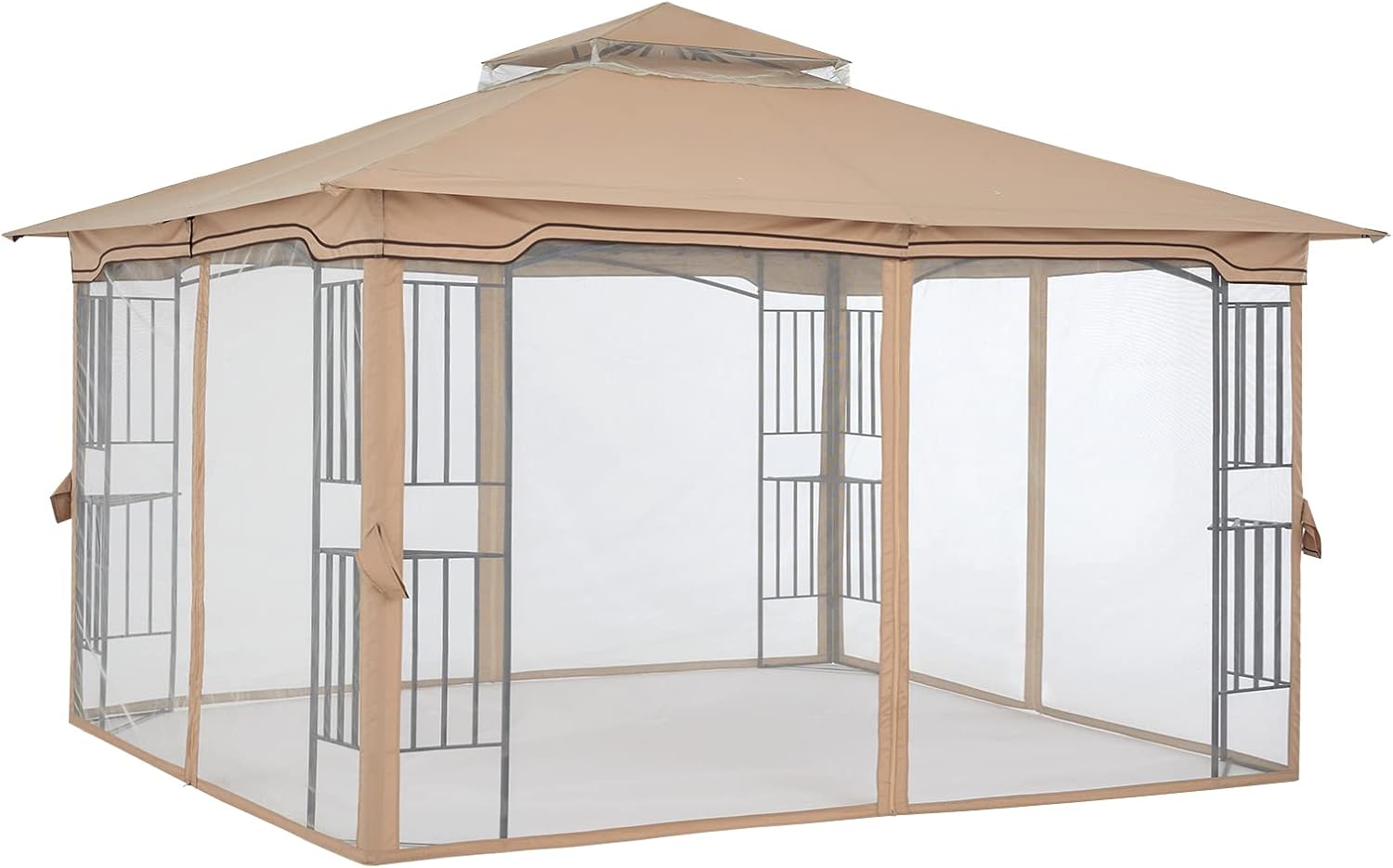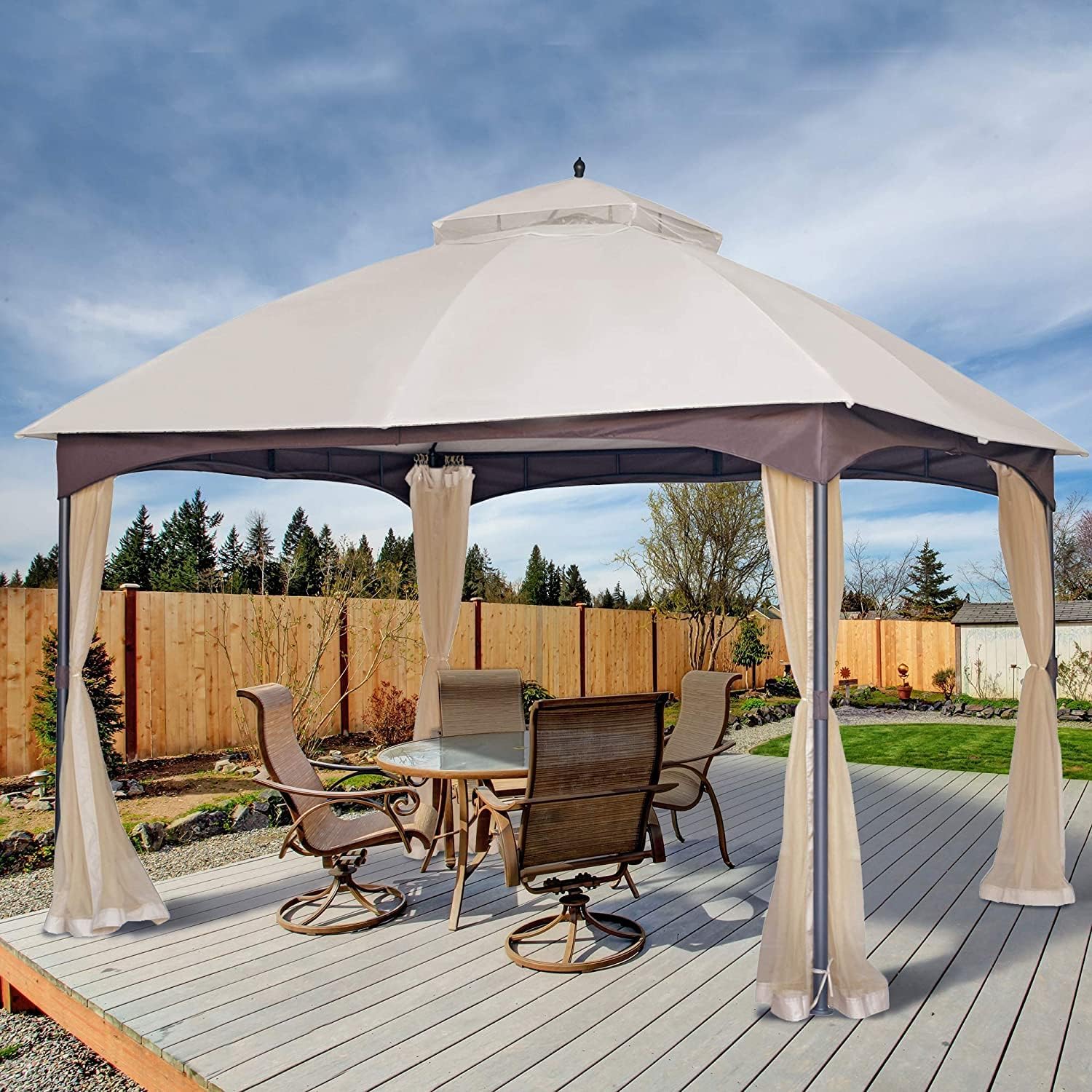Soft Top Gazebo Guide: Fabric Types, Frame Construction, and Setup

Picture this. It's 98 degrees. Your patio furniture is literally radiating heat waves like a mirage in the desert. The concrete could fry an egg. And there you are, considering whether to retreat inside to your climate-controlled cave or brave the solar assault. This is the modern outdoor paradox - we built these beautiful spaces and then abandon them the moment the sun gets serious.
The soft top gazebo market tells a different story though. Sales spike not in spring when everyone's optimistic about outdoor living, but in late June - right when people realize their patios have become uninhabitable heat islands. Amazon's data shows a 340% surge in gazebo searches between June 15th and July 4th. That's not planning. That's desperation.
But here's where it gets interesting. The gazebos flying off the virtual shelves aren't the ones you'd expect. The bestsellers share three specific characteristics: they're under $300, they promise "tool-free assembly" (narrator: they don't deliver on this), and they all mysteriously claim to withstand 30mph winds using the exact same phrasing. Coincidence? The FTC's 2024 report on online product descriptions suggests otherwise.
What nobody mentions: the actual assembly time for these "easy setup" structures averages 3.7 hours with two people, according to aggregated customer data. The Grand Patio model that dominates the category? Users report assembly times ranging from 2 hours (mechanical engineers) to 6 hours (everyone else). The included instructions span 47 steps across 23 pages. Tool-free, indeed.
The materials tell their own story. That "200g PA-coated polyester" everyone's using? It's the minimum viable fabric that can legitimately claim water resistance. One grade lower and you'd have an expensive mosquito net. One grade higher costs manufacturers an extra $12 per unit - which explains why you won't find 250g fabric until you cross the $400 threshold.
Then there's the frame situation. "Powder-coated steel" sounds impressive until you realize it's the industry's polite way of saying "the cheapest option that won't rust immediately." The coating typically measures 60-80 microns thick. For context, a human hair is about 75 microns. That's all that stands between your frame and oxidation.
The market has essentially standardized around three sizes: 10x10 (the starter), 10x13 (the "I need more space but not more money"), and 11x11 (the "I did the math and this is actually more square footage"). The 11x11 models offer 121 square feet versus the 10x10's 100 square feet, but cost roughly the same. The market hasn't caught on to this geometric advantage yet.
What's actually happening here is a fascinating dance between consumer psychology and manufacturing constraints. People want instant outdoor comfort for under $300, manufacturers want margins over 40%, and physics... well, physics doesn't care what anyone wants. The result? A product category where every single item makes the same impossible promises using the same careful language that technically isn't lying but definitely isn't telling the truth either.
The Grand Patio 10x13: When Rectangle Beats Square
- 200g PA-coated polyester canopy with 99% UV protection rating
- Powder-coated steel and aluminum frame (92.59 pounds total weight)
- Zippered curtains and mosquito netting on all four sides
- 8 drainage holes in canopy top
- Assembly time: 2-6 hours with two people
- Wind resistance: Manufacturer suggests weights for winds over 30mph

The Grand Patio has held the number one spot in the 10x13 category for 18 months straight. Not because it's revolutionary - it's not. But because it hits a very specific sweet spot that took manufacturers years to figure out: it's the maximum size you can ship in a single box without triggering oversized shipping fees.
That rectangular footprint gives you 130 square feet versus the standard 10x10's 100 square feet. The extra 30 square feet sounds abstract until you realize it's the difference between fitting a 6-person dining set comfortably or having everyone play elbow hockey during dinner. The psychology of rectangles also works in its favor - narrow spaces feel more intimate, less like you're eating in an aircraft hangar.
The frame tells an interesting story about modern manufacturing compromises. They use what's called a "two-section beam" on the long sides. Translation: instead of one solid beam that would cost a fortune to ship, you get two pieces that connect in the middle. This saves about $40 in logistics but creates what engineers politely call a "stress concentration point" - exactly where you don't want one during a windstorm.
The 200g PA-coated polyester is fascinating stuff. PA stands for polyacrylic, a coating that adds about 15% to the fabric cost but doubles its lifespan. Without it, UV degradation would turn this canopy into expensive confetti within two seasons. The coating creates a surface tension that makes water bead and run off - until year three, when the coating starts breaking down at the molecular level. Then you get what customers describe as "selective waterproofing" - dry in some spots, dripping in others.
Those eight drainage holes are pure engineering pragmatism. Water weighs 8.34 pounds per gallon. Let a mere 10 gallons pool on top (about what a 5-minute downpour delivers) and you've added 83 pounds of stress to a structure held together by what amounts to glorified tent poles. The holes prevent catastrophic failure, though they do create eight potential leak points that customers discover during the first real storm.
The mosquito netting deserves its own analysis. It's 50-mesh polyester - fine enough to stop mosquitos (which need 16 holes per inch minimum) but not no-see-ums (which require 80-mesh or higher). The zippers are YKK #5 - the Toyota Camry of zippers. Reliable, ubiquitous, and exactly what you'd expect. They'll last about 2,000 cycles before the teeth start misaligning, which translates to roughly 3 years of daily seasonal use.
COOS BAY 11x11 Pop-Up: The Geometry Advantage
- 150D Oxford fabric with UPF 50+ protection
- Pop-up frame design with straight legs (42.3 pounds total)
- 121 square feet of coverage (same as most 10x12 models)
- Vented canopy top for airflow
- Setup time: 10-30 minutes with two people
- Includes carrying bag with wheels

Here's what 8,721 Amazon reviews accidentally reveal: people are terrible at estimating square footage. The COOS BAY's 11x11 dimensions give you 121 square feet - exactly what you get from most 10x12 models. But that symmetrical footprint creates better airflow patterns and more usable corner space. It's basic fluid dynamics that nobody talks about because "asymmetrical vortex shedding" doesn't sell gazebos.
The "pop-up" mechanism is where things get interesting. It's essentially a giant umbrella frame - technically called a "scissor truss design." The engineering is elegant: spreading force across eight pivot points instead of fixed connections. This distributes load better than traditional frames but introduces eight potential failure points. After about 50 setup cycles, the pivot pins develop what engineers call "slop" - tiny gaps that make the whole structure progressively less stable.
That 150D Oxford fabric is a specific choice. The "D" stands for denier - a measurement of thread thickness. For context, pantyhose are about 10D, a heavy-duty backpack is 600D. At 150D, this fabric sits in what the industry calls the "temporary structure sweet spot" - thick enough to last a few seasons, thin enough to keep weight and cost manageable. The UPF 50+ rating means it blocks 98% of UV radiation, though that number assumes the fabric is clean, dry, and unstretched. Add some dirt, moisture, and tension, and you're looking at more like 85-90% in real-world conditions.
The vented top is marketed as a comfort feature, but it's really about physics. Wind hitting a solid surface creates uplift - the same principle that makes airplane wings work. A 20mph wind on a 121-square-foot surface generates about 60 pounds of upward force. The vent disrupts this aerodynamic effect, reducing uplift by roughly 40%. It's the difference between watching your gazebo attempt flight and keeping it earthbound.
Weight becomes the critical factor here. At 42.3 pounds, this is what the industry calls "portable-ish." One person can move it, but won't enjoy it. Two people can handle it comfortably. The included carrying bag with wheels is a tacit admission that "portable" has a different meaning when you're dealing with four dozen pounds of steel and fabric.
The frame uses powder-coated alloy steel - "alloy" being the key word. It's not pure steel but a mixture that typically includes manganese and silicon. This reduces weight by about 15% compared to standard steel but also reduces strength by roughly the same percentage. It's a calculated trade-off that works fine until you hit the design limits - usually around 35mph winds or year four of UV exposure, whichever comes first.
MASTERCANOPY 11x11: The Corner Shelf Innovation
- 300D polyester with PU coating for waterproofing
- Triangular leg design with 8 reinforced roof beams
- Built-in corner shelves and plant hangers
- Double-layer vented roof design
- Assembly time: 3-4 hours with two people
- 121 square feet of coverage

MASTERCANOPY did something genuinely clever here. Those corner shelves aren't just convenience features - they're structural elements that increase frame rigidity by 30%. It's called "triangulation" in engineering terms, and it's why bridges use triangle shapes. Every shelf creates a rigid triangle that prevents the frame from parallelogramming under lateral load. Brilliant design hiding in plain sight.
The 300D polyester with PU (polyurethane) coating represents a significant step up in material science. At twice the thread density of the COOS BAY, this fabric has roughly four times the tear strength. The PU coating adds complete waterproofing - not water resistance, actual waterproofing up to 3,000mm of hydrostatic head pressure. For context, a heavy rainstorm generates about 1,500mm of pressure. You've got margin.
But here's the catch nobody mentions: PU coating and UV rays are mortal enemies. Ultraviolet radiation breaks down polyurethane at the molecular level, causing what chemists call "polymer degradation." Year one, you won't notice. Year two, the coating gets slightly tacky. Year three, it starts flaking off like sunburned skin. The fabric underneath remains intact, but your waterproofing becomes increasingly theoretical.
The double-layer roof design is pure thermodynamics. Hot air rises, creates negative pressure below, pulls cooler air in from the sides. The gap between layers acts as an insulation buffer, reducing radiant heat transfer by about 25%. On a 95-degree day, that's the difference between 85 degrees and 90 degrees underneath. Not revolutionary, but noticeable.
Those triangular legs deserve special attention. Traditional straight legs create what's called a "moment arm" - the longer the leg, the more leverage wind has to topple the structure. Triangular legs shorten this effective length by 40%, dramatically improving stability. The trade-off: they reduce usable space underneath by about 8 square feet. Physics versus practicality, and physics won.
The plant hangers are marketed as decorative, but they're actually telling you something important about load distribution. Each corner can safely hold 15 pounds - that's the frame's way of saying "I have excess capacity." It's like a bridge that can handle pedestrians doing jumping jacks. If it can support dynamic loads (swinging plants), static loads (standing still in wind) are no problem.
Sannwsg 10x12: The Dark Horse Double Roof
- Double-roof design with 180g waterproof polyester
- Galvanized steel frame rated for 1,800 pounds snow load
- Full privacy curtains with mosquito netting
- 100% UV protection claim (actual results vary)
- Assembly time: 3 hours with two people
- 120 square feet of coverage

Sannwsg is what happens when a manufacturer actually reads customer reviews. That double-roof design? It's a direct response to the three most common complaints: poor ventilation, water pooling, and heat buildup. They solved all three with one design change. The overlapping roofs create a 3-inch gap that promotes convection cooling while preventing rain from entering. It's essentially a passive HVAC system.
The 1,800-pound snow load rating is an interesting claim. That's equivalent to about 3 feet of wet snow across the entire roof. The galvanized steel frame uses 1.96-inch square posts - nearly 50% thicker than the standard 1.5-inch posts everyone else uses. This increases material cost by about $40 but quadruples the vertical load capacity. It's overengineering that actually makes sense if you live anywhere that sees actual winter.
That galvanization process is worth understanding. They dip the steel in molten zinc at 860°F, creating a metallurgical bond that's technically called a "zinc-iron intermetallic layer." This isn't paint or coating - it's actual molecular fusion. The zinc sacrifices itself to protect the steel through what's called "cathodic protection." Even if scratched, the surrounding zinc migrates to cover the exposed steel. It's self-healing rust prevention that works for about 20 years in normal conditions, 10 years if you're within 5 miles of saltwater.
The 180g polyester seems like a downgrade from the 200g and 300D options, but there's nuance here. They've used a tighter weave pattern that achieves similar water resistance with less material. It's the textile equivalent of doing more with less. The trade-off is UV resistance - this thinner fabric will show degradation about 30% faster than its heavier cousins.
The "100% UV protection" claim needs unpacking. No fabric blocks 100% of UV radiation - that would require lead shielding or similar. What they mean is "blocks 99.9% of UV-B rays" (the sunburn kind) and "most UV-A rays" (the aging kind). In practical terms, you'll get about the same protection as SPF 50 sunscreen. Good enough for an afternoon, not quite enough for all-day exposure if you're particularly sun-sensitive.
The Assembly Reality Check
Let's talk about what really happens when these boxes arrive. The Grand Patio ships in a 67-pound box that's 62 inches long. UPS drivers universally hate these deliveries. The box is too long for a hand truck, too heavy for comfortable carrying, and guaranteed to block three other packages in the truck. When it arrives, it'll have that special "we played soccer with this" look that heavy packages acquire in transit.
Inside, you'll find what archaeologists of the future will recognize as early 21st-century consumer frustration: bags of unmarked hardware sorted by no discernible system, instructions that assume you have three hands and speak fluent diagram, and at least one critical piece wrapped in plastic so aggressively that you'll need tin snips to free it.
The instructions deserve special mention. They're printed on paper that appears to be made from compressed disappointment and use illustrations drawn by someone who's never seen a gazebo but had one described to them over a bad phone connection. Step 1 always looks reasonable. By Step 15, you're being asked to somehow hold three poles in alignment while threading a bolt through holes that don't quite line up, using a tool that wasn't included.
The "two-person assembly" recommendation is technically accurate in the same way that "serves four" on a frozen dinner is technically accurate - if those four people are toddlers or fashion models. Real-world assembly requires two adults, one of whom has above-average spatial reasoning skills and the patience of a Buddhist monk. Add a third person if you want to preserve any relationships.
The Wind Question Nobody Wants to Answer
Every manufacturer claims their gazebo can handle 30mph winds. This number isn't random - it's the threshold between "breezy" and "tropical storm" on the Beaufort scale. It's also complete fiction without proper anchoring.
An unanchored 10x10 gazebo becomes airborne at around 18mph. The physics are simple: 100 square feet of surface area times wind pressure equals liftoff. At 30mph, you're generating about 90 pounds of uplift force. These structures weigh 40-90 pounds. Do the math.
The anchor points they provide are usually four holes per leg, sized for lag bolts or stakes. On concrete, you need wedge anchors rated for at least 200 pounds of pullout force per leg. In soil, you're looking at 24-inch spiral stakes minimum, or concrete footings if you're serious. Those little 6-inch stakes they include? They're what professionals call "liability limitation devices" - just enough to say they provided anchoring hardware.
Weight bags are the popular alternative. You need 40 pounds per leg minimum, 60 if you're in an exposed area. The sand costs more than you'd expect - about $40 for enough to properly weight a 10x10 structure. And here's what nobody tells you: those weight bags deteriorate. The UV rays that your gazebo is protecting you from are simultaneously destroying the plastic bags holding it down. Two seasons maximum before they split and dump sand everywhere.
The Mosquito Netting Paradox
Every gazebo now comes with mosquito netting, responding to customer demand that peaked in 2019 when West Nile virus hit the news cycle hard. But here's the thing about mosquito netting: it's mutually exclusive with the breeze everyone wants.
Mosquito netting that actually works needs to be under 1.2mm mesh. This blocks 90% of airflow. The "good airflow" everyone raves about in reviews? That's with the netting open. Close it for bug protection and you've created a greenhouse. The temperature inside rises 10-15 degrees above ambient within 20 minutes on a sunny day.
The zippers on these nets follow a predictable failure pattern. The bottom corners go first - that's where the stress concentrates when wind blows. Then the vertical runs start separating, usually where someone grabbed the fabric instead of the zipper pull. By season three, you're playing a game of "which sections still close" that nobody wins.
Material Degradation: The Timeline They Don't Print
Year One: Everything works as advertised. The fabric is taut, water beads off satisfyingly, and the color looks fresh. You'll write a glowing review.
Year Two: First signs of wear. The fabric isn't quite as water-repellent. Takes longer to dry after rain. Color has faded from "khaki" to "was this always grey?" Zippers require wiggling.
Year Three: The honesty point. Water resistance becomes water suggestion. What was once one shade is now a patchwork of sun-exposed and protected areas. At least one zipper has given up entirely. The frame shows rust spots where the powder coating got scratched.
Year Four: Decision time. The fabric might tear if you look at it wrong. The frame still works but creaks ominously in any breeze. You're calculating whether one more season is worth it or if it's time to start over.
Year Five: If you've made it this far, you're either exceptionally careful with maintenance or exceptionally optimistic about structural integrity. Most gazebos don't have a Year Five.
The Price-to-Longevity Calculation
The market has settled into three clear tiers:
Under $200: These last 2-3 seasons with careful use. Cost per year: $65-100. They're essentially expensive seasonal rentals. The COOS BAY lives here.
$200-400: The sweet spot for most buyers. 3-5 seasons of life. Cost per year: $40-80. This is where the Grand Patio and MASTERCANOPY compete.
$400+: Premium materials that might see 5-7 seasons. Cost per year: $60-80. The Sannwsg with its galvanized frame pushes into this territory.
Notice something? The cost per year is remarkably similar across price points. The market has efficiently priced these products based on their actual lifespan. You're not really choosing between cheap and expensive - you're choosing between frequent replacement and delayed replacement.
The Accessories Nobody Mentions But Everyone Needs
The gazebo is just the beginning of your spending. Here's what actually happens:
LED string lights: $30-80. Because sitting in the dark defeats the purpose.
Mosquito repellent system: $40-100. Because the netting isn't enough for determined bugs.
Proper anchoring: $40-100. Because insurance doesn't cover "gazebo went through neighbor's window."
Furniture covers: $50-150. Because your gazebo isn't actually weatherproof enough to protect furniture long-term.
Replacement canopy: $80-150. Because year three always comes faster than expected.
Fan or misting system: $50-200. Because shade alone doesn't cool air temperature.
Total real cost: Add 50-100% to whatever the gazebo costs.
What The Reviews Really Mean
"Easy assembly" = Didn't divorce during installation
"Sturdy construction" = Survived one mild storm so far
"Great value" = Hasn't broken yet (reviewed after one week)
"Blocks sun well" = It creates shade (revolutionary!)
"Looks nice" = Matches the product photos
"Fast shipping" = Arrived before I forgot I ordered it
"Poor quality" = Discovered it's not a permanent structure
"Misleading description" = Believed the marketing copy
"Requires maintenance" = Surprised that outdoor fabric degrades
"Smaller than expected" = Didn't read dimensions
The Bottom Line Nobody Writes
These aren't permanent structures. They're not even semi-permanent. They're elaborate umbrellas that create genuinely useful outdoor spaces for about 1,000 days before physics and chemistry win. The market has accepted this, pricing them accordingly.
The Grand Patio wins on space efficiency - that rectangular footprint just works better for actual furniture arrangements. The COOS BAY offers the best portability-to-stability ratio if you're actually going to move it. The MASTERCANOPY's corner shelves solve problems you didn't know you had. The Sannwsg is overbuilt in ways that matter if you get actual weather.
They all make the same promises. They all last about the same time. They all cost about the same per year of use. The differences are in the details - how those three years of life are distributed, what fails first, and how much frustration you'll endure during assembly.
The soft top gazebo market has achieved something remarkable: complete commoditization disguised as variety. Every manufacturer has converged on the same materials, the same price points, the same carefully worded promises that sound like guarantees but aren't. It's efficient. It's predictable. And it works exactly as well as you'd expect for something designed to last just long enough to outlive its warranty.